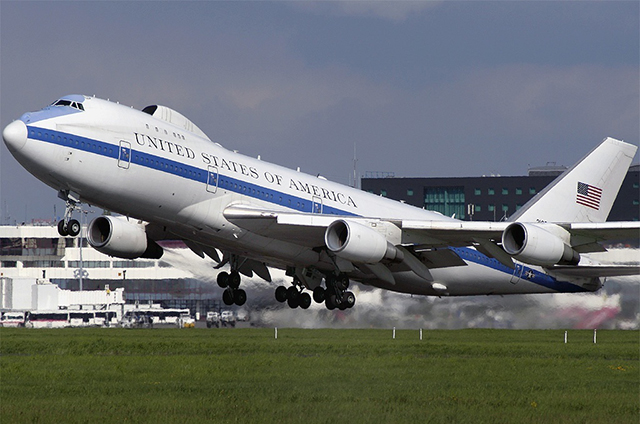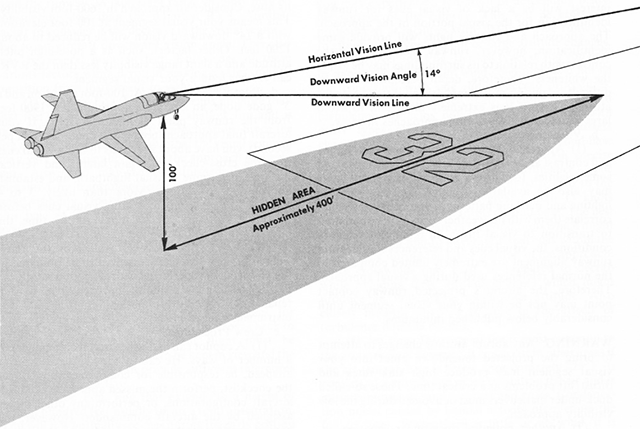The subject of deck angle comes up in two extremes, not enough or too much: The natural tendency in the Boeing 747 and, to a lesser extent, in the GV, was to aim for the first inch of pavement, thinking that is where the airplane was headed. The natural tendency in smaller aircraft is to look at the runway distance remaining markers on touchdown and consider that the point where the wheels contacted the runway.
— James Albright
. . . a loaded deck
We didn’t seem to worry about it in the T-38, but somebody did and they taught us the concept of “look down angle,” the earliest spot the pilot can see when on approach to landing while learning to fly the white rocket. Years later, while flying the Boeing 747, I found the topic relevant again.
It was easy enough to solve:
Hidden area = altitude / tangent (look down angle)
= 100 / tan (14°)
= 400’
I immediately threw out the concept of lookdown angle, at least as the manual was preaching it, as something to worry about. There were two lessons that didn’t necessarily relate to the lookdown angle that did seem to be important. First, the pilot’s aim point — the point on the windscreen that appears to be stationary — is not where the wheels will touch, even without a flare to round out the flight path. Secondly, what the pilot’s eyes see at touchdown are not an accurate indication of where the wheels touched.
The Boeing 747 flight manual says if you are on a 3 degree glide path with a 5 degree body angle, when your eyes are 52 feet above the runway your wheels are only 10 feet above. In this position your aim point is 1,000 feet down the runway but your wheels will touch nearly 700 feet earlier. The airplane is 225 feet long and the body gear is 114 behind the nose. Clearly the math isn’t simple addition and subtraction.
In a three-point attitude, the pilot’s eyes are 27 feet above and 100 feet ahead of the main landing gear wheels.
When in an approach attitude, the aircraft angle — what 747 pilots call “deck angle,” is 5 degrees nose high.
While the manual doesn’t specify a look down angle, it does give the geometry of the approach at 1,000 feet from touchdown: the pilot’s eyes will be 52’ above the runway.
Incredibly, if the pilot doesn’t flare, the wheels will touchdown almost 800’ behind the aim point! That goes a long way explaining why every 747 pilot wants to look at a set of these:
More about this: VASI.
Post Script
You don't have to be flying a Boeing 747 to have deck angle issues bite you, as a Global Express crew found out on the way to destroying a practically brand new aircraft. More about this: BD-700 C-GXPR.
All aircraft have deck angle issues and these issues are amplified by the aircraft's length, eye wheel height, and glide path. The G450, for example, will touch down 300 feet short of its aim point if the pilot doesn't flare off a 3° glide path. More about this: Aim Point versus Touchdown Point.







